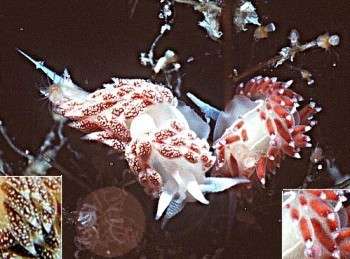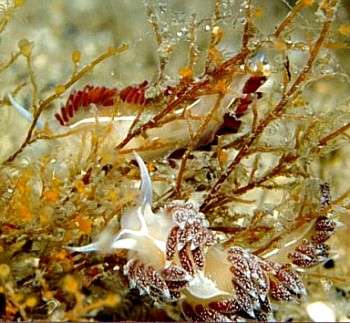Flabellina from Florida
April 5, 2000
From: Anne DuPont


Hello Bill,
How are things at the museum?
On March 5, 2000, West Palm Beach, Florida, in about 12 feet of water, I photographed these two nudibranchs (size about 1 inch)
together on a night dive. I photographed them together again on March 19 (lower photo).
I did not know if it was (1) a romantic encounter to mating, (2) a fight or (3) someone is having lunch! I also could not identify them.
I sent the photos to Sandra Millen at UBC and her comments are:
" The animal in the background with smooth rhinophores, red cerata and three white lines is typical of an undescribed
Flabellina found in Florida, the Gulf of Mexico and the Caribbean. The animal in the foreground may be a color variety or a different species altogether." (Sandra Millen, UBC)
Do you know who they are? Or what their behavior indicates?
Thank you.
Cordially,
Anne DuPont
PS: Sandra gave me permission to use her comments.
adupont@gate.net
Anne DuPont, 2000 (Apr 5) Flabellina from Florida. [Message in] Sea Slug Forum. Australian Museum, Sydney. Available from http://www.seaslugforum.net/find/2199Note added 24 November 2007: This has been identified as Flabellina verta.
Thanks Anne & Sandra.
Both animals seem to have the same white lines so perhaps they are just colour forms of one species. It's a pity we don't have more information on living Flabellina engeli Marcus, 1968 [Curacao, Colombia, Florida (Marcus 1977)] and Coryphella dushia Marcus, 1963 [Curacao] which were both described from preserved material. They seem to be the only two flabellinids reported from the Caribbean.
On what they are doing? I suspect the attraction is the hydroid colony they are on, which through close proximity will almost certainly lead to mating if they are the same species. If you look at the top photo, I have highlighted a spot at the bottom of the photo where you can see an egg string, typical of a flabellinid. I suspect this has been produced by some of your animals. When aeolids find a source of their food they usually stay there feeding, mating and laying eggs until they die or they eat the colony out.
Best wishes,
Bill Rudman.
Related messages
-
Flabellina verta feeding
From: Anne DuPont, November 24, 2007
